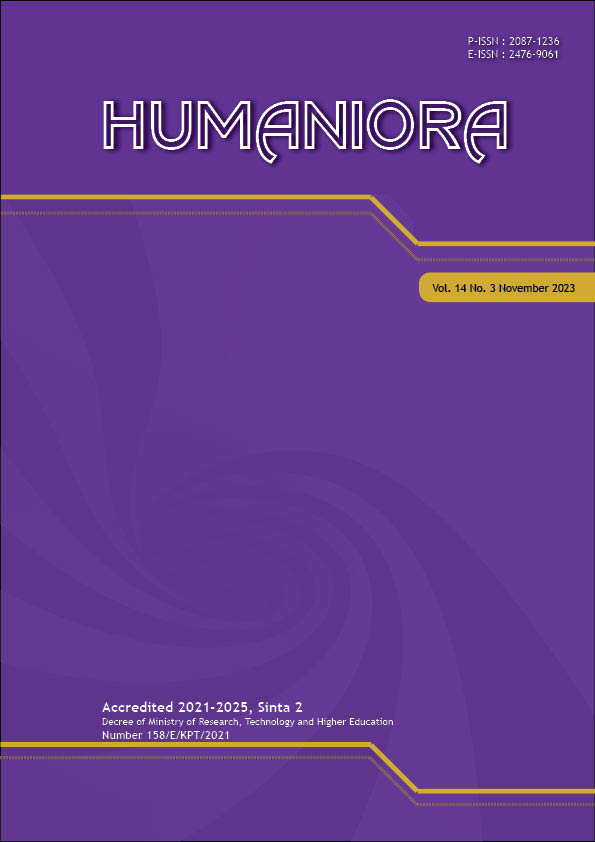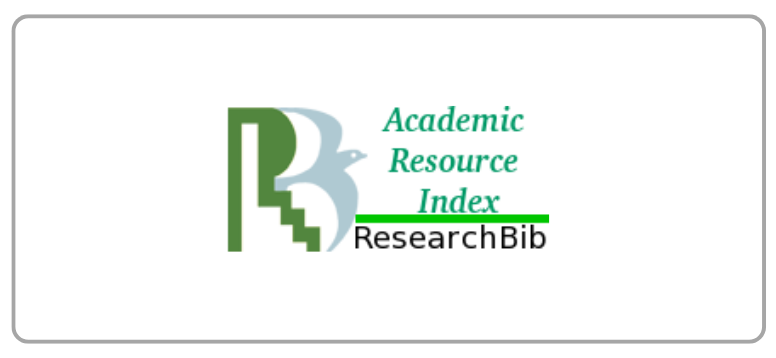Traditional Wayang Research Productivity: A Bibliometric Analysis
DOI:
https://doi.org/10.21512/humaniora.v14i3.9211Keywords:
traditional wayang, wayang, puppet, bibliometric, research productivityAbstract
The aim of the research was to review the productivity of Wayang’s research by using the bibliometric method from the Scopus database. Wayang is a form of traditional art recognized by UNESCO as a Masterpiece of the Oral and Intangible Heritage of Humanity since 2003. It was not obtained easily, especially in terms of the world community’s introduction of shadow puppets. Puppet research has exploded since it was recognized by UNESCO. However, global indexed publications still needed to be enhanced. Analysis of Wayang research from internationally indexed journals, such as Scopus, was required to recognize this opportunity; the object could be seen from a different perspective. The dataset used was ‘Traditional Wayang’, based on documents during 2015-2021 from the Arts and Humanities areas. The search has found 36 papers related to ‘Traditional Wayang’ research. The number of Wayang studies in Scopus-indexed papers remains limited, retaining the Wayang perspective as a traditional object. This is shown by the 36 documents examined, among which only two clusters are produced: performance and change. In order for Wayang research to have great potential and be considered from a wide range of perspectives, including technological, social, economic, commercial, and other, there are still other types of Wayang as an object material.
Plum Analytics
References
Andryanto, S. D. (2021). Kisah UNESCO mengakui wayang kulit sebagai warisan dunia asal Indonesia. Retrieved from https://nasional.tempo.co/read/1530239/kisah-unesco-mengakui-wayang-kulit-sebagai-warisan-dunia-asal-indonesia.
Anggoro, B. (2018). Wayang dan seni pertunjukan: Kajian sejarah perkembangan seni wayang di tanah Jawa sebagai seni pertunjukan dan dakwah. JUSPI: Jurnal Sejarah Peradaban Islam, 2(2), 122-133. http://dx.doi.org/10.30829/j.v2i2.1679.
Awalin, F. R. N. (2018). Sejarah perkembangan dan perubahan fungsi wayang dalam masyarakat. Jurnal Kebudayaan, 13(1), 77-89. http://dx.doi.org/10.24832/jk.v13i1.234.
Braginsky, V., & Suvorova, A. (2008). A new wave of Indian inspiration: Translation from Urdu in Malay traditional literature and theatre. Indonesia and Malay World, 36(104), 115-153. http://dx.doi.org/10.1080/13639810802017867.
Cohen, M. I. (2007). Contemporary wayang in global context. Asian Theatre Journal 24(2), 338-369.
Cohen, M. I. (2014). Traditional and post-traditional wayang kulit in Java today. The Routledge Companion to Puppetry and Material Performance (178-191). Abingdon: Routledge.
Cohen, M. I. (2016). Global modernities and post-traditional shadow puppetry in contemporary Southeast Asia. Third Text, 30(3-4), 188-206. https://doi.org/10.1080/09528822.2017.1305728.
Fauziah, F., Cahya, C., & Lahpan, N. Y. K. (2021). Perubahan fungsi pertunjukkan wayang golek purwa dari sakral ke profan pada syukur laut Pamayangsari. Jurnal Budaya Etnika, 5(1), 35-56. http://dx.doi.org/10.26742/be.v5i1.1591.
Guntur, G. (2021). The artistry and creative process in the making of malang masks in East Java. SPAFA Journal, 5, 1-27. https://doi.org/10.26721/SPAFAJOURNAL.2021.V5.636.
Hand, R. (2017). Approaches to learning traditional performing arts in Central Java through a direct encounter. Malaysian Music Journal, 6(2), 29-48. https://doi.org/10.37134/mjm.vol6.2.2.2017.
Jatinurcahyo, R., & Yulianto, Y. (2021). Menelusuri nilai budaya yang terkandung dalam pertunjukan tradisional wayang. Khasanah Ilmu: Jurnal Pariwisata dan Budaya, 12(2), 159-165. https://doi.org/10.31294/khi.v12i2.11440.
Kholidah, H., Hijriah, H. Y., Mawardi, I., Huda, N., Herianingrum, S., & Alkausar, B. (2022). A bibliometric mapping of peer-to-peer lending research based on economic and business perspective. Heliyon, 8, e11512. https://doi.org/https://doi.org/10.1016/j.heliyon.2022.e11512,
Lukens-Bull, R. (2008). The traditions of pluralism, accommodation, and anti-radicalism in the pesantren community. Journal of Indonesian Islam, 2(1), 1-15. https://doi.org/10.15642/JIIS.2008.2.1.1-15.
Pandin, M. G. R. (2020). Moral-ethics-belief values towards indonesian puppet (Wayang kulit) performance arts. Utopia y Praxis Latinoamericana, 25, 515-521. https://doi.org/10.5281/zenodo.3784909.
Parikesit, G. O. F. (2016). 3D wayang kulit: Traditional shadow puppetry meets modern display technology. International Journal of Arts and Technology, 9(2), 162-172. https://doi.org/10.1504/IJART.2016.077238.
Pratama, D., Dharsono, D., Haryono, T., & Sarwanto, S. (2019). The history of Wanda in the Surakartan style wayang kulit Purwa. American Research Journal of Humanities Social Science (ARJHSS), 2(1), 1-6.
Romain, J. (2016). “All art is part of the same constellationâ€: A conversation on craft and artistic practice with Heri Dono. Journal of Modern Craft, 9(2), 183-191. https://doi.org/10.1080/17496772.2016.1205282.
Santoso, S. A., & Harpawati, T. (2020). Pertunjukan wayang kulit Madya Lakon Aji Pamasa Sanggit Ki Purbo Asmoro. Wayang Nusantara Journal of Puppetry, 4(2), 56-70. https://doi.org/10.24821/wayang.v4i2.3804.
Subiyantoro, S., Kristiani, & Wijaya, Y. S. (2020). Javanese cultural paradoxism: A visual semiotics study on wayang purwa characters of satria and raseksa figures. Harmonia: Journal of Arts Research and Education, 20(1), 19-28. https://doi.org/http://dx.doi.org/10.15294/harmonia.v20i1.17525.
Sulistiyani, & Indah, D. R. (2019). The symbolic meaning of “Punakawan Javanese Wayang†(A value imaging study in character education at the character education course in STKIP Bina Insan Mandiri Surabaya). SELL (Scope of English Language Teaching, Linguistics, and Literature) Journal, 4(2), 99-106.
Sumarni, E., & Nihayati. (2018). Kajian bibliometrik dan sebaran topik penelitian pada jurnal standardisasi terbitan tahun 2013-2017. Seminar Kepustakawanan LPNK Ristek. Serpong, Indonesia, 25 July 2018.
Wibowo, A., Kurnain, J., & Juanda, J. (2020). History of inheritance of Wayang Topeng Malangan (Malang traditional mask puppet) in Pakisaji and Tumpang. Harmonia: Journal of Arts Research and Education, 20(1), 73-83. https://doi.org/10.15294/harmonia.v20i1.24785.
Wijana, I. D. P. (2019). Wayang properties in the use of Indonesian and Javanese. In O. A.H. (Ed.), 2019 Conference of the Global Council on Anthropological Linguistics in Asia, GLOCAL 2019 (Vols. 2019-January, pp. 136–142). London: Global Council on Anthropological Linguistics.
Yang, S., Liu, J., Yang, W., & Guo, Z. (2019). Context-aware text-based binary image stylization and synthesis. IEEE Transactions on Image Processing, 28(2), 952-964. https://doi.org/10.1109/TIP.2018.2873064.
Downloads
Published
How to Cite
Issue
Section
License
Copyright (c) 2023 Donna Carollina, Mita Purbasari

This work is licensed under a Creative Commons Attribution-ShareAlike 4.0 International License.
Authors who publish with this journal agree to the following terms:
a. Authors retain copyright and grant the journal right of first publication with the work simultaneously licensed under a Creative Commons Attribution License - Share Alike that allows others to share the work with an acknowledgment of the work's authorship and initial publication in this journal.
b. Authors are able to enter into separate, additional contractual arrangements for the non-exclusive distribution of the journal's published version of the work (e.g., post it to an institutional repository or publish it in a book), with an acknowledgment of its initial publication in this journal.
c. Authors are permitted and encouraged to post their work online (e.g., in institutional repositories or on their website) prior to and during the submission process, as it can lead to productive exchanges, as well as earlier and greater citation of published work.
USER RIGHTS
All articles published Open Access will be immediately and permanently free for everyone to read and download. We are continuously working with our author communities to select the best choice of license options, currently being defined for this journal as follows: Creative Commons Attribution-Share Alike (CC BY-SA)
























